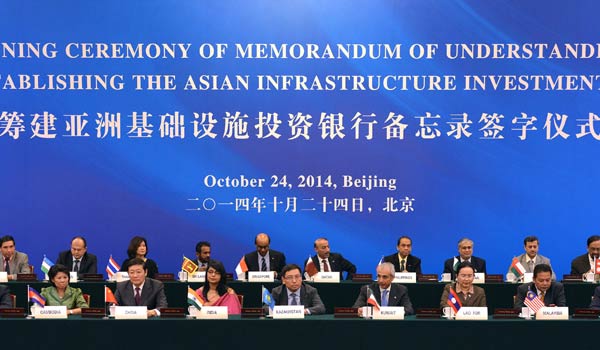 |
|
The signing ceremony of memorandum of understanding on establishing the Asian Infrastructure Investment Bank (AIIB) is held in Beijing, Oct 24 2014. [Photo/Xinhua] |
The establishment of the Asian Infrastructure Investment Bank, and the proposals of the Silk Road Economic Belt and the 21st Century Maritime Silk Road for integration with economies along the two roads are bold but not challenging moves by China. Yet they are not intended to rewrite established rules of global economic governance.
The China-ASEAN Free Trade Agreement covers the world's largest free trade area in terms of population and is the third-largest in terms of nominal GDP. China is indeed moving fast in upgrading its trade ties with major economies. And the fact that its three FTA partners - Australia, Canada and the Republic of Korea - are strategic allies of the United States suggests China doesn't consider the US-led security alliance as an obstacle to trade liberation and investment protection.
These may be China's geo-strategic moves, but of all the FTAs in the Asia-Pacific, the Trans-Pacific Partnership Agreement is by far the most geo-strategic in nature. The irony is that despite not being part of the TPP, China doesn't differ that much with the US in terms of the texts of the treaties under negotiation. The China-US Bilateral Investment Treaty is envisioned to include all sectors and all stages of investment. Plus, the BIT's contents are similar to those in the TPP's investment chapter.
So, what is keeping Beijing and Washington apart in the TPP process? The short answer is that neither Beijing nor Washington would want to share the negotiation room with the rest of the TPP players. Geopolitical considerations certainly play a role, for the TPP, according to US analysts, is as much about leadership competition as it is about trade and investment.
China's efforts to build the Free Trade Area of the Asia-Pacific could also be seen as a geo-strategic move. Unlike the TPP, the FTAAP will not draw a dividing line in the Pacific, but still the US has not suggested a specific timeline for the FTAAP. China, nevertheless, has started a collective strategic study on how to build the FTAAP. Hopefully, this compromise will hold.

I’ve lived in China for quite a considerable time including my graduate school years, travelled and worked in a few cities and still choose my destination taking into consideration the density of smog or PM2.5 particulate matter in the region.